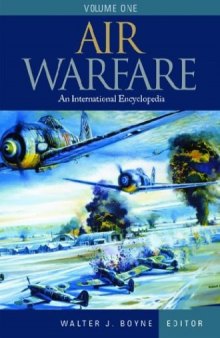دانلود کتاب Air Warfare: An Encyclopedia 2 Volume set
by Walter J. Boyne|
|
عنوان فارسی: جنگ هوایی : یک دانشنامه مجموعه 2 دوره |
 دانلود کتاب
دانلود کتاب
 جزییات کتاب
جزییات کتاب
The AIR WARFARE set includes over 990 entries which range from several paragraphs to ten pages or more. Boyne's team of 100+ contributors includes Donald Caldwell, Kev Darling, David Isby, Alwyn Lloyd, Birch Matthews, George Mellinger, Steve Pace and Warren Thompson.
The first entry in AIR WARFARE is a two-page article on Aces; the last, a one-page biography of Secretary of the Air Force Eugene Zuckert. In between the reader can find information - and sometimes photographs and/or maps - on French aviation pioneer Clement Ader, Aeritalia, Civil War Balloons, the National Security Act of 1947, USS Liberty, B-17 designer Ed Wells, the Mu Gia Pass, the Jointness doctrine, Dick Bong, 1967's Operation Bolo, Douglas MacArthur, Francisco Franco, Gasoline, the Italo-Turkish War of 1911-12, Aeroflot, Sputnik, Enlisted pilots in American military services, Engine technology, Douhet's COMMAND OF THE AIR book, the Commonwealth of Independent States, Zero-Length Launchers, Martin Aircraft, the Mutal Assured Destruction doctrine, Saab Aircraft, WW I aviation, WW II aviation, nonlethal wepons, the Taranto raid, the 1989 Panama invasion, FIELD MANUAL 100-20, the Tacamo communications system, Erich Hartmann, and so on.
Related items may rate separate articles. For instance, there are entries on the Mitsubishi Zero and its designer, Jiro Horikoshi. Likewise, entries may be subdivided. The topic of Missiles features articles on Air-to-Air/Air-to-Surface missiles, Intermediate Ballistic missiles, Intermediate Range Ballistic missiles and Surface-to-Air missiles,
Questions will undoubtedly arise about selection. Some may question a few entries - such as the Polish Auxiliary Women's Air Force Service, Scott O'Grady and Hector Worden (1st native American pilot). Or the lack of entries such as Charles Lindbergh. From my own standpoint, I wondered why, for instance, the Normandie-Niemen Regiment deserved space when more noteworthy units - both Allied and Axis - were not covered? Likewise, why were their separate entries for the Saab J-29, J-35, J-37 and J-39 but not for the Nieuport 11, 16, 17, etc.? Historically the Nieuport fighters made a much greater contribution than the Saabs.
Generally the articles seem balanced and accurate. The Billy Bishop article, for instance, notes that most of his victory claims are highly suspect. One of the few gaffes I found was the statement in the Marc Mitscher article that his carrier "contribute(ed) significantly to the sinking of four irreplaceable Japanese cariers." In fact, the USS Hornet air wing's strike was a complete foul-up, achieving nothing. On top of that, Mitscher submitted a summary report that was less than accurate.
I have several problems with some AIR WARFARE entries. When describing individual commanders, too often the entry is a laundry list of commands held with not enough emphasis being given as to WHY that individual was significant. George Kenney's entry, for instance, does not allude to his 5th AF tactical innovations nor to the very real impact he had on the SWPA campaign.
I also question the length of some articles. Are Presidential Aircraft so important that they deserve two pages? The 1937 USS Panay attack rates 3/4-page; the Office of the Secretary of the Navy, 1/2-page; Eddie Rickenbacker gets 2 pages (yet General Kenney, mentioned above, gets 1/4-page).
Given the dimensions of the subject, Boyne & Co. did a good job of willowing down and presenting concise yet accurate summaries of aviation movers and shakers, bells and whistles, theories and doctrines. An immense undertaking, AIR WARFARE: AN INTERNATIONAL ENCYCLOPEDIA stands alone as a valuable, wide-ranging research tool accessible to specialists and general readers alike. Recommended.









 این کتاب رو مطالعه کردید؟ نظر شما چیست؟
این کتاب رو مطالعه کردید؟ نظر شما چیست؟
